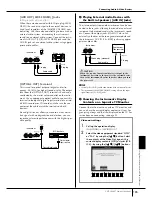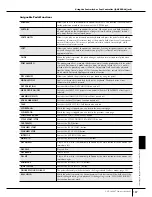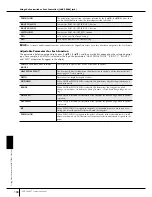
Using
Your Instrument with Other Devices
CVP-309/307 Owner’s Manual
198
MIDI Settings
MIDI System Settings
The explanations here apply to the SYSTEM display to
be called up in step 4 of the “Basic Operation” on
page 196.
■
LOCAL CONTROL
Determines whether the Clavinova is controlled by its
own internal clock or a MIDI clock signal received from
an external device. INTERNAL is the normal Clock set-
ting when the Clavinova is being used alone or as a
master keyboard to control external devices. If you are
using the Clavinova with an external sequencer, MIDI
computer, or other MIDI device, and you want to syn-
chronize it to that device, set this parameter to the
appropriate setting: MIDI, USB 1, or USB 2. In this case,
make sure that the external device is connected prop-
erly (e.g., to the Clavinova’s MIDI IN terminal), and that
it is properly transmitting a MIDI clock signal. When
this is set for control by an external device (MIDI, USB
1 or USB 2), the Tempo is indicated as “Ext.” in the
Main display
■
Clock setting, etc.
●
CLOCK
Determines whether the Clavinova is controlled by its
own internal clock or a MIDI clock signal received from
an external device. INTERNAL is the normal Clock set-
ting when the Clavinova is being used alone or used to
control external devices as the master keyboard. If you
are using the Clavinova with an external sequencer,
MIDI computer, or other MIDI device, and you want to
synchronize it to that device, set this parameter to the
appropriate setting: MIDI, USB 1, or USB 2. In this case,
make sure that the external device is connected prop-
erly (e.g., to the Clavinova’s MIDI IN terminal), and that
it is properly transmitting a MIDI clock signal. When
this is set to an external device (MIDI, USB 1 or USB 2),
the Tempo is indicated as “Ext.” in the Main display.
●
TRANSMIT CLOCK
Turns MIDI clock (F8) transmission on or off. When set
to OFF, no MIDI clock or Start/Stop data is transmitted
even if a Song or Style is played back.
●
RECEIVE TRANSPOSE
Determines whether or not the instrument's transpose
setting (page 55) is applied to the note events received
by the instrument via MIDI.
●
START/STOP
Determines whether incoming FA (start) and FC (stop)
messages affect Song or Style playback.
■
MESSAGE SW
●
SYS/EX.
The “Tx” setting turns MIDI transmission of MIDI Sys-
tem Exclusive messages on or off. The “Rx” setting turns
MIDI reception and recognition of MIDI System Exclu-
sive messages generated by external equipment on or
off.
●
CHORD SYS/EX.
The “Tx” setting turns MIDI transmission of MIDI chord
exclusive data (chord detect. root and type) on or off.
The “Rx” setting turns MIDI reception and recognition
of MIDI chord exclusive data generated by external
equipment on or off.
MIDI Transmit Settings
The explanations here apply to the TRANSMIT display
to be called up in step 4 of the “Basic Operation” on
page 196. This determines which parts will be sent as
MIDI data and over which MIDI channel the data will
be sent.
Operation
Select the part to be transmitted and the channel via
which the selected part will be transmitted. You can also
determine the types of data to be sent.
●
With the exception of the two parts below, the
configuration of the parts is the same as those
already explained elsewhere in this manual.
• UPPER
The keyboard part played on the right side of the key-
board from the Split Point for the Voices (RIGHT1 and/
or 2).
• LOWER
The keyboard part played on the left side of the keyboard
from the Split Point for the Voices. This is not affected by
the on/off status of the [ACMP ON/OFF] button.
SYSTEM display
TRANSMIT display
















































